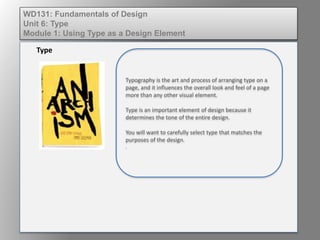
Wd131 unit 6 module 1 using type as design
- 1. Typography is the art and process of arranging type on a page, and it influences the overall look and feel of a page more than any other visual element. Type is an important element of design because it determines the tone of the entire design. You will want to carefully select type that matches the purposes of the design. . Type WD131: Fundamentals of Design Unit 6: Type Module 1: Using Type as a Design Element
- 2. Type is one way of communicating a visual message. It is essential that designers understand the key typographic terms in order to successfully utilize letterforms for communicating ideas. Type WD131: Fundamentals of Design Unit 6: Type Module 1: Using Type as a Design Element
- 3. Type WD131: Fundamentals of Design Unit 6: Type Module 1: Using Type as a Design Element Font Letterform Character Dingbat Kerning Leading Baseline Ascender Descender Counter X-Height A single weight and design of a given typeface, including capital and lowercase letters, numbers, and punctuation.
- 4. Type WD131: Fundamentals of Design Unit 6: Type Module 1: Using Type as a Design Element Font Letterform Character Dingbat Kerning Leading Baseline Ascender Descender Counter X-Height The shape of a letter and the unique characteristics of its strokes.
- 5. Type WD131: Fundamentals of Design Unit 6: Type Module 1: Using Type as a Design Element Font Letterform Character Dingbat Kerning Leading Baseline Ascender Descender Counter X-Height The individual form of each letterform, number, or symbol in a given typeface.
- 6. Type WD131: Fundamentals of Design Unit 6: Type Module 1: Using Type as a Design Element Font Letterform Character Dingbat Kerning Leading Baseline Ascender Descender Counter X-Height You may know someone who fits this description, but in type this refers to an ornamental symbol used for emphasis or decoration.
- 7. Type WD131: Fundamentals of Design Unit 6: Type Module 1: Using Type as a Design Element Font Letterform Character Dingbat Kerning Leading Baseline Ascender Descender Counter X-Height This refers to the adjustment of the spacing between individual pairs of letters.
- 8. Type WD131: Fundamentals of Design Unit 6: Type Module 1: Using Type as a Design Element Font Letterform Character Dingbat Kerning Leading Baseline Ascender Descender Counter X-Height It is the length of distance between one baseline and the line above it.
- 9. Type WD131: Fundamentals of Design Unit 6: Type Module 1: Using Type as a Design Element Font Letterform Character Dingbat Kerning Leading Baseline Ascender Descender Counter X-Height The invisible line upon which the characters of a typeset line, except the descenders, appear to sit.
- 10. Type WD131: Fundamentals of Design Unit 6: Type Module 1: Using Type as a Design Element Font Letterform Character Dingbat Kerning Leading Baseline Ascender Descender Counter X-Height The upward vertical stem of some lowercase letters, such as h and b, which extends above or ascends beyond the x-height
- 11. Type WD131: Fundamentals of Design Unit 6: Type Module 1: Using Type as a Design Element Font Letterform Character Dingbat Kerning Leading Baseline Ascender Descender Counter X-Height The downward portion of some lowercase letters, such as g and y, which extends below or descends beyond the baseline
- 12. Type WD131: Fundamentals of Design Unit 6: Type Module 1: Using Type as a Design Element Font Letterform Character Dingbat Kerning Leading Baseline Ascender Descender Counter X-Height The space within an enclosed character.
- 13. Type WD131: Fundamentals of Design Unit 6: Type Module 1: Using Type as a Design Element Font Letterform Character Dingbat Kerning Leading Baseline Ascender Descender Counter X-Height The height of lowercase letters, excluding ascenders and descenders.
- 14. Type WD131: Fundamentals of Design Unit 6: Type Module 1: Using Type as a Design Element